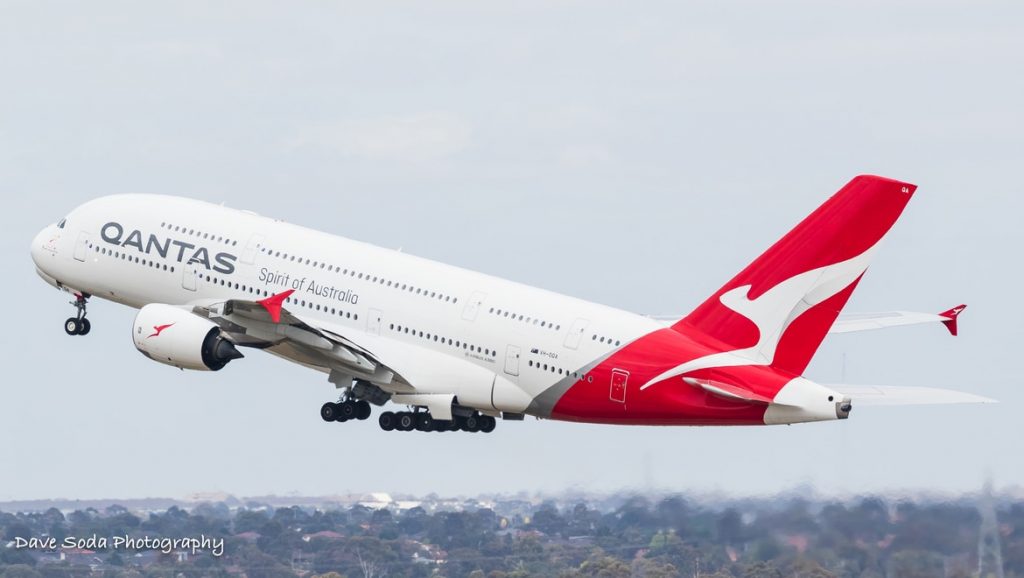
On Thursday, Qantas announced it will bring 10 of its 12 Airbus A380s back into service, five of which are set to return to the skies in 2022, while the remaining two A380s will be retired.
It marks the beginning of the end of Qantas’ iconic A380 fleet, following the decided end of the Airbus A380 program, as Airbus nears delivery of its last-ever A380 to Emirates.
As such, now seems an appropriate time to take a look back on the career of the Flying Kangaroo’s 12 superjumbos, and perhaps even deduce which Qantas A380s we see soon returning to passenger service, and which two may instead have a different destiny.
Qantas announced its order of all 12 of its current A380 fleet on 29 November 2000 and saw all 12 ultimately delivered between September 2008 and December 2011.
Unfortunately, due to the COVID-19 pandemic, between March and August 2020, Qantas moved nearly all of its A380 fleet into long-term storage at the Victorville ‘boneyard’ in the California desert – with a few notable exceptions.
Don’t forget to have your say! Let us know which jets you see making a comeback, and which you think are grounded for life in our poll at the bottom.
Now – let’s get into it.
VH-OQA – Nancy Bird Walton
VH-OQA, Qantas’ very first A380, was officially handed over at the Henri Ziegler Delivery Centre within Airbus’ Toulouse headquarters on 19 September 2008. The jet was named after ‘The Angel of the Outback’ Nancy-Bird Walton.
On 4 November 2010, Nancy-Bird Walton experienced an uncontained explosive engine failure shortly after take-off from Singapore, with engine debris puncturing the aircraft’s wing, and damaging its fuel tank. The tank ultimately caught fire, however miraculously, the pilots on board were able to maneuver VH-OQA back to Changi Airport, with no injuries reported.
A little over 18 months later, on 24 April, 2012, Nancy-Bird returned from Singapore to Sydney following the most extensive – and expensive – aircraft repair in Qantas’ modern history.
At the beginning of the COVID-19 pandemic in March 2020, VH-OQA was grounded and stored at Qantas’ hangar in Sydney, before being flown to the Victorville ‘boneyard’ in July 2020. She remains there to this day.
Of course, there are many sentimental ties to Qantas’ very first A380. With a name as iconic as Nancy-Bird Walton, it would be surprising to see her left in the Californian desert at the end of this crisis. However, as one keen-eyed Australian Aviation commentator suggested, perhaps Qantas would consider donating VH-OQA to one of Australia’s aviation museums to be preserved and admired by future generations, should she be among the two not chosen to return to service.
VH-OQB – Hudson Fysh
Named after one of Qantas’ founding members, VH-OQB was delivered to the airline on 15 December 2008, and completed her first passenger service from Sydney to LA as QF11 on 22 December 2008.
In 2019, VH-OQB struck scaffolding as it was being rolled out of the Qantas maintenance hangar at Sydney airport, resulting in one of its doors being almost entirely ripped from its body, however the damage was quickly repaired.
Hudson Fysh was one of just two of Qantas’ superjumbos that were grounded at a purpose-built A380 hangar at LAX, rather than stored at the Victorville ‘boneyard’ in the California desert, and was just last week flown from storage at LAX to a facility in Dresden, Germany, for maintenance ahead of a planned refurbishment.
This could suggest VH-OQB could be among the first five Qantas A380s to come home, and personally, we here at Australian Aviation would be surprised to see her among the two retired.
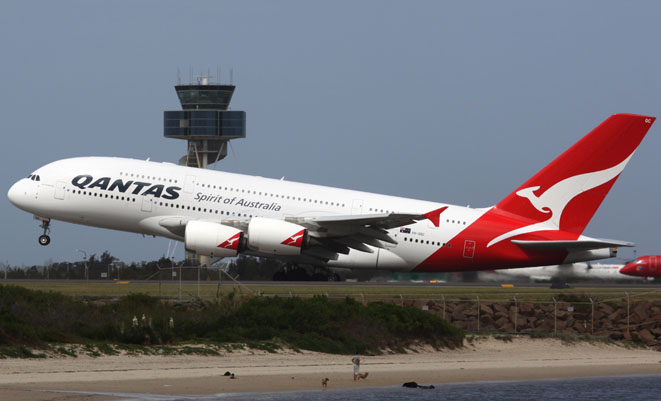
VH-OQC – Paul McGinness
Also named after a Qantas founder, VH-OQC was delivered to the airline on 16 December 2008.
Paul McGinness performed a number of key inaugural flights, including the inaugural A380 service from Sydney to San Francisco as QF73 on 14 January 2009, as well as the inaugural A380 Melbourne Tullamarine to London (via Singapore) service as QF9 on 18 January 2010.
The jet was moved to long-term storage at Victorville in July 2020, however was moved to LAX on 20 May 2021. The following month, VH-OQC was ferried to Abu Dhabi International airport in the UAE. While Qantas often performs heavy maintenance on its A380s in Abu Dhabi, it appears the aircraft is simply in storage there, for now.
VH-OQD – Fergus McMaster
VH-OQD was Qantas’ fourth A380, delivered to the airline on 22 August 2009, and performed its first revenue flight, Sydney to London via Singapore as QF31, on 29 August 2009. The aircraft was dubbed Fergus McMaster, also named after a founder of Qantas.
Notably, VH-OQD is one of just two A380s that were stored at Qantas’ purpose-built A380 hangar at LAX, and never made the trip to the aircraft ‘boneyard’ in Victorville, California. Fergus McMaster was ferried from London Heathrow to Abu Dhabi for maintenance on 7 March 2020, before being ferried to Los Angeles on 25 July 2020, where she has remained since.
Could such preferential treatment perhaps mean VH-OQD will be among the first five A380s to return?
VH-OQE – Lawrence Hargrave
Named after British-born Australian engineer, inventor and aeronautical pioneer Lawrence Hargrave, VH-OQE was delivered to Qantas on 19 December 2009. VH-OQE performed its first revenue service, Sydney to London via Singapore as QF31, on Christmas Day 2009.
The superjumbo was initially stored at Melbourne Tullamarine at the beginning of the pandemic, from March to July 2020, before being ferried to the aircraft boneyard in Victorville, where it still remains.
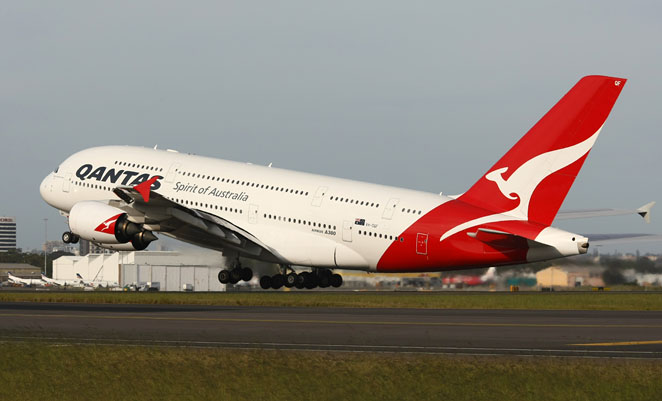
VH-OQF – Charles Kingsford Smith
Delivered to Qantas on 8 January 2010, VH-OQF became the sixth A380 to enter into the fleet. Named after famous early Australian aviator Sir Charles Kingsford Smith, VH-OQF performed its first passenger service from Sydney – Los Angeles as QF11 on 17 January 2010.
In March 2018, VH-OQF became the first Qantas A380 to sport the airline’s new ‘Silver Roo’ livery, after being repainted at the Emirates Aircraft Appearance Centre in Dubai. In July 2020, Charles Kingsford Smith was ferried directly to Victorville, and has remained there since.
VH-OQG – Charles Ulm
VH-OQG, Qantas’ seventh A380, was delivered to the airline on 17 December 2010. Named after pioneering Australian aviator and Sir Charles Kingsford Smith’s co-pilot Charles Ulm, VH-OQG performed its first revenue service as QF31 from Sydney to London via Singapore on 20 December 2010.
Charles Ulm was ferried from Singapore to Dresden on 2 February, 2020 for maintenance as QF6019, and was later ferried from Dresden to Victorville on 21 August 2020, for long-term storage.
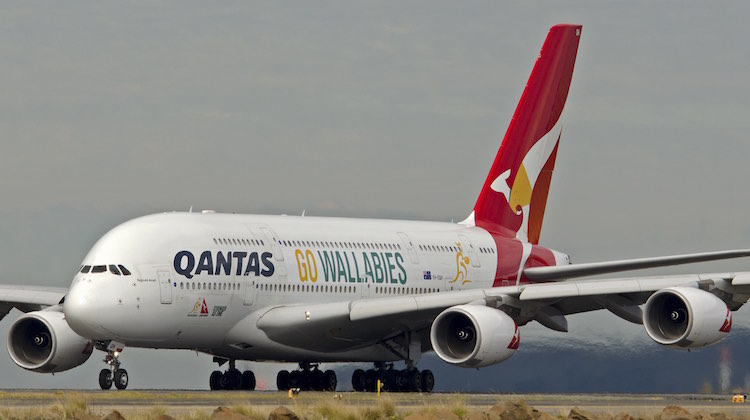
VH-OQH – Reginald Ansett
Qantas’ eighth A380, VH-OQH, was delivered on 30 January 2011, and named after Ansett Airlines founder Sir Reginald Ansett. VH-OQH operated its first passenger service on 5 February 2011, performing QF31 from Sydney – Singapore – London.
From July 2015 to November 2016, VH-OQH sported a special ‘Go Wallabies’ livery. The aircraft was used to fly the Wallabies to London for the Rugby World Cup in 2015. In April 2020, Reginald Ansett was ferried from Sydney to Melbourne, and later, on 13 July 2020, moved to Victorville, California, for long-term storage.
VH-OQI – David Warren
While technically the ninth A380 ordered by Qantas, VH-OQI was delivered just prior to the eighth, VH-OQH, on 13 January 2011. As with many of these A380s, VH-OQI performed its first revenue service as QF31 from Sydney to London via Singapore, on 17 January 2011.
In March 2020, the superjumbo, named after Australia scientist and creator of the ‘black box’ David Warren, was ferried from Sydney to Dresden for maintenance. Then on 25 September 2020, VH-OQI was ferried again to – you guessed it – Victorville for long-term storage.
VH-OQJ – Bert Hinkler
VH-OQJ was delivered to Qantas on 8 April 2011, and dubbed Bert Hinkler, after Herbert Hinkler, an Australian aviator and inventor who became the first person to fly solo from England to Australia.
Again, VH-OQJ also performed its first passenger service as QF31 from Sydney to London via Singapore, on 12 April 2011. VH-OQJ performed its last revenue service to date as QF11 from Sydney to Los Angeles on 24 March 2020. Bert Hinkler was ferried from LAX to Victorville for long-term storage on 7 July 2020.

VH-OQK – John Duigan / Reginald Duigan
The second-to-last A380, VH-OQK, was delivered to Qantas on 25 November 2011, and was given two names – after the Duigan brothers, John and Reg, who constructed and flew the first Australian-made aircraft.
As such, VH-OQK bears the name John Duigan on the port side, and Reginald Duigan on the starboard side. VH-OQK performed its first passenger service – as QF31 – on 7 December 2011. On 2 April 2020, VH-OQK was ferried from Sydney to Melbourne, before being moved to the Victorville boneyard on 22 July 2020.
VH-OQL – Phyllis Arnott
VH-OQL was the twelfth and final A380 to be delivered to Qantas, on 16 December 2011. The aircraft was named after Phyllis Arnott, an early Australian female aviator regarded as the first Australian woman to earn her Commercial Pilot’s Licence, in 1929.
VH-OQL performed its first passenger service from Sydney to LAX as QF11 on 22 December 2011, and its last service to date was QF2 from Darwin to Sydney on 27 March 2020. Phyllis Arnott has been stored at Victorville since 18 July 2020.
So what do you think? Let us know below!




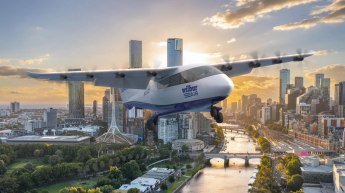











Himeno
says:The 6 aircraft which completed their cabin refits prior to the pandemic are unlikely to be retired now. So that’s OQD, OQG, OQH, OQI, OQJ and OQK.
OQB has gone to get refit now, suggesting it will be one of the first to return.
Which leaves OQA, OQC, OQE, OQF and OQL as likely retirement options.
The repairs to OQA after the QF32 incident made it heavier then the other frames. I think OQA is a likely option for an early retirement.
Sunset
says:I thought OQA was basically zero houred as part of its repair. yes the repair made it slightly heavier, IIRC less than 100kg but the fact that the first 5 frames are all early builds and heavier than the later ones due to Airbus needing to do structural fixes will mean they would likely be the ones to go.
IMO OQC and OQE are the ones to go if OQA stays.
Craigy
says:OQA won’t be retired. The aircraft retired will be the two with the most hours out of those which have not had their cabins upgraded.
PaulE
says:What we need to know is which are the aircraft that have been refurbished with the new Business Class seats. You can guarantee those will be returning to the sky’s.
Andrew C
says:OQA/B/C/E/F/L have not had the cabin refresh.
Then remove OQL (youngest), and OQB (planned maintenance + refit in Dresden), OQC (in Abu Dhabi pending maintenance and possible short hop onwards to Dresden for refit), and OQA (Nancy Bird for sentimental reasons), that leaves OQE and OQF as the odd ones out to go.
The variations could be that they scrap OQA due to the prior damage / repairs, or that OQC has been positioned to Abu Dhabi in preparation for parting out instead of maintenance.
john doutch
says:My money is on OQA and OQC (50 cents each way!)
Al
says:OQA & OQC to be retired
OQD was the first of the ‘Wave 2’ aircraft to have the redesigned electric harness fitted and has new interior, so it along with OQE through OQL, plus OQB to stay in the fleet.
Neil
says:I am thinking that OQA, being one of the oldest in the fleet, & it’s flying hours, a few incidents, could be restored at an Australian Aviation Museum.
,which leaves either OQE ,or OQF. The others are more likely to be Refitted, Refurbished and returned to service.
Richard de Crespigny
says:OQA, B and C are First Wave aircraft (MSN < 26) that have Basic Weights about 1000kg more than later aircraft – before the latest refit.
Remarkably, and unfortunately, the first few aircraft to be refitted came out with close to 3t of extra fat, equivalent to losing 28 passengers on every max takeoff weight flight. I hope this fat has been trimmed.
So my guess is OQA and OQB will remain in storage.
Andrew C
says:Interesting insight about the extra weight Richard – I wasn’t aware of that. I’m sure you have sentimental reasons to want to see OQA stick around, even if in a museum. I looked back at my trip notes and you flew me on 3 separate occasions on OQA, including one News Years MEL -DXB when we had to divert down to DWC due to fog in DXB and spent a few hours on the ground coming up with funny limericks from the cabin.
I remember you had to wait for a fresh crew to be bussed down from DXB because you were out of hours – and you even gave out your personal mobile over the PA so we could call you if any issues with onwards connections etc (nice touch). I sat opposite you in the F cabin when you had to pax back up to DXB, so can’t complain really as it was more comfortable that 20+ hours in Economy. I recall there were a few bad WX induced diverts around that week with some flights also going down to Al Ain or across to Muscat.
Justin
says:Pffffft, what would you know…. 😉
ELT
says:Hi Richard, I used to run into you as an engineer in SYD. One of the things not mentioned by anyone here is the damage done to OQF during a jacking incident to her horizontal stab during maintenance in SYD. As you may remember she carries a penalty as a result. If I had to pick it, I would name OQF and OQA as likely candidates. And possibly OQA being brought back at some point as a museum piece.
Rowan McKeever
says:Well naturally I’m at least partially inclined to take your word for it 😉
However, since OQB was just recently ferried to DRS where the refits are being done and, by my estimations, OQC has already undergone heavy maintenance at AUH, for me that leaves OQA, OQE & OQF as the most likely to retire. I’m in two minds as to whether OQA would stay or go – as someone else has mentioned, I understand she was effectively zero-houred after QF32 and her weight gain during the repair (especially in the context of your comments about the added weight of the new configuration!) is relatively minimal.
So, on balance, I’m going with OQE & OQF as our retirees.
ELT
says:Hi Rowan, let me dispel a myth. OQA was NOT zero timed as has been mentioned multiple times here and on other social media outlets. The repair to her left wing and main spar did not afford her any effective extra hours of airframe life. To be honest I think this has come about due to either journalist misinterpretation or the rumor mill, quite likely due to misunderstanding of the term “zero G configuration”, which is what the aircraft was put into during the repair process. This involved a veritable forest of aircraft jacks (I forget how many but over a dozen) that put the wing into a relaxed state so that it could be cut and repaired. A special one off tool at a cost of around $1 million was attached to the damaged area and allowed it to be carefully removed and shipped. A repair was then manufactured and placed on the tooling before shipping back to Singapore for installation and attachment. This repair is now evident by two prominent “doublers” at the inboard and outboard ends of the repair which are visible on the ground and make OQA unique in the A-380 world.
Mandy Squair
says:Yes, I agree with Richard – OQA and OQB.
Mac Carter
says:Should OQA be retired, it would make a great addition to the Qantas Founders Museum at Longreach.
I recon OCA and OCF will be retired, hopefully both will be preserved for future generations to enjoy.
Both would make excellent airworthy flying exhibits.
Paul. C
says:OQA should be given a few more years of service and then be retired in 2025 and preserved at HARS next to OJA.
S.E
says:It is an amazing site to be at QFOM and see EQB’s huge tail standing up above everything else. Now just imagine OQA’s tail towering over everything as well! I’d love to see that.